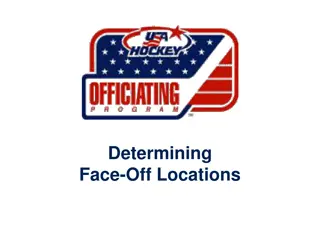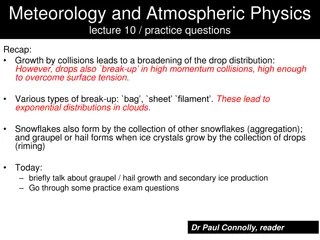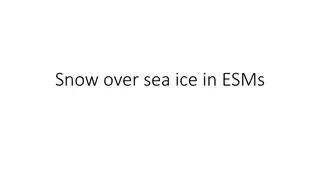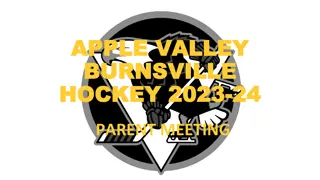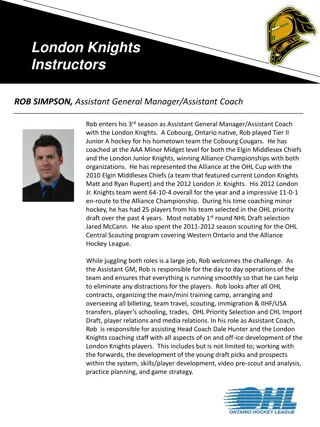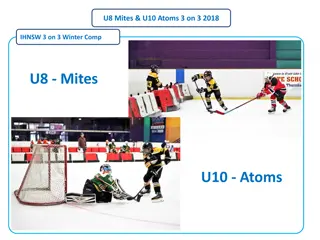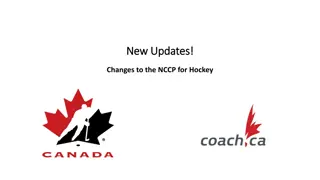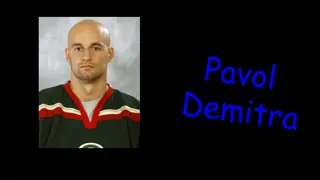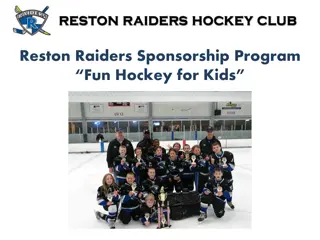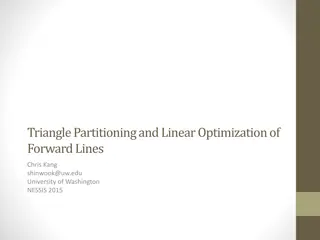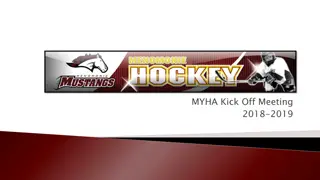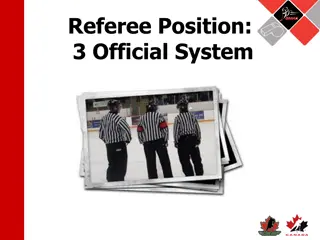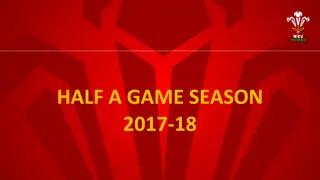Understanding the Transition to Half-Ice Hockey for Novice Players
This content discusses the transition from full ice to half ice for Novice players in hockey, as mandated by Hockey Canada for the 2019-2020 season. It highlights the benefits of the half-ice program in developing fundamental hockey skills and enhancing player engagement. Various experts share insights on the importance of age-appropriate skills programming and the differences between half-ice and cross-ice hockey formats.
Download Presentation

Please find below an Image/Link to download the presentation.
The content on the website is provided AS IS for your information and personal use only. It may not be sold, licensed, or shared on other websites without obtaining consent from the author. Download presentation by click this link. If you encounter any issues during the download, it is possible that the publisher has removed the file from their server.
E N D
Presentation Transcript
HEO Novice Programming 2019-2020
Tom Renney Tom Renney discussing the transition from Full Ice to Half Ice for Novice https://www.youtube.com/watch?v=qFxET27 26CY 2
Hockey Canada Mandate: To accept the recommendation that the Novice age group shall only use half ice for all game play effective the 2019-20 season. Mandate Carried
TOP 5 REASONS . . . KIDS PLAY SPORT 1. To have fun 2. To do something they re good at 3. To improve their skills 4. To stay in shape 5. To get exercise Institute for the Study of Youth Sports, Michigan State University (1989) 4
Why Novice Half Ice? The program serves as the gateway to all hockey skills! 5
An innovative program approach . . . FUNdamental sports skills: Age appropriate skills programming FUNdamental hockey skills: Basic overall game skills Skills in combination over time "Learning the basic skills at a young age will set the foundation for everything a player will accomplish in the game of hockey. Corey McNabb, Hockey Canada Director, Hockey Development Pro 6
The difference . . . Half-ice hockey Cross-ice hockey 7
No limitations on how to use ice . . . Half-ice hockey: 2 games 1 game and a skills area Half-ice hockey 8
Difference from IP to Novice? Difference between Cross Ice and Half Ice: Cross Ice (IP): Played in a smaller surface Played with Smaller nets Played with Blue pucks Half Ice (Novice): Played on larger ice surface than IP Regulation sized nets Regulation (Black) puck 9
Why change to Half Ice? 1. Scaling down is important and the research shows that when children are more actively engaged, they touch the puck more often, have the puck on their stick longer, and are interacting with one another to a greater extent. Dr. Stephen Norris, Consultant to Hockey Canada You have to be able to make plays in pretty small areas. The more you practice in small spaces the better off you are. Sidney Crosby, Canada s National Men s Team 10
Body Contact and Puck Battles 2 X Greater Full Ice Cross Ice 11 * USA Hockey Study
Shots Per Player 6 X Greater Full Ice Cross Ice 12 * USA Hockey Study
Individual Player Puck Touches 2 X More Full Ice Cross Ice 13 * USA Hockey Study
Shots on Goal Every Minute 1.75 shots .45 shots Full Ice Cross Ice 14 * USA Hockey Study
Pass Attempts 2 X Greater Full Ice Cross Ice 15 * USA Hockey Study
Pass Receptions 5 X Greater Full Ice Cross Ice All stats courtesy of USA Hockey 2014 16
A GRASSROOTS-UP APPROACH There is resistance to change within the hockey culture. Who needs to hear the message? Families (Players and Parents) Coaches Minor Hockey Associations Leagues
Frequently Asked Questions What is the the key driver for the shift to the new Novice format? Hockey Canada developed the program to ensure that a child s early experiences with hockey are delivered in a safe and positive experience. The program enables participants to become contributing members of a team effort, develop self-confidence and experience a sense of personal achievement. The goals of the program are: To have fun while playing hockey and engaging in physical activity. To learn the fundamental skills required to play the game of hockey. To develop and refine basic motor patterns. To be introduced to the concepts of cooperation and fair play. 18
Frequently Asked Questions Get small kids off full size adult rinks and into an age/size appropriate game playing area Get kids more engaged in game play, provide more enjoyment for kids in the games and less boredom Increase skill development in games by decreasing space and increasing the puck touches and skill executions Provide a more logical progression from cross ice game play at IP 19
Frequently Asked Questions Who is developing the changes to the Novice program? Hockey Canada has established a Task Team made up of representatives from all of the branches across Canada including HEO. This Task Team has been meeting for several months and is developing a set of consistent policies and standards for implementation in 2019-2020. 20
Frequently Asked Questions How can we be sure that the Hockey Canada policies will accurately represent issues relevant to Hockey Eastern Ontario? HEO has a representative on the Hockey Canada Task Team. In addition, as part of the HEO Development Committee, a HEO/HEO Minor Novice Sub-Committee has been struck. There are representatives from Districts and Associations within the branch to reflect our local issues and concerns. 21
Frequently Asked Questions Will the half-ice program be mandatory? Yes. However, it is understood that there is a wide variety of half-ice delivery options to accommodate different local conditions so as the policies are developed, they will designed with some degree of flexibility so those local conditions can be accommodated. 22
Frequently Asked Questions WiIl the new Novice program be open to IP players? No. No players under 7 years of age will be permitted to play in the Novice program. 23
Frequently Asked Questions Will there still be tiering ? It is still anticipated that there will be tiering (where registrant levels permit) to reflect the difference in skill levels. It s possible that there could be changes to the existing tiering models or the number of tiers as the teams continue their work. 24
Frequently Asked Questions What will happen to the Novice competitive programs? Hockey Canada has not taken a position on competitive hockey only that all Novice programs must be delivered in half ice format. As This will be discussed as part of the HEO Development sub-committee 25
Frequently Asked Questions Will the number of players per team change? This is one of the issues that will be reviewed by the HEO Development Sub-committee. 26
Frequently Asked Questions Will the new program impact program costs or result in increases/decreases in registration costs? Although the specifics of the program is still in development, it is not expected that this will have a material impacts of costs either up or down. 27
Questions Any questions can be directed to Jeff Robert HEO s Development Programs Officer jrobert@hockeyeasternontatio.ca 28





